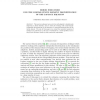Free Online Productivity Tools
i2Speak
i2Symbol
i2OCR
iTex2Img
iWeb2Print
iWeb2Shot
i2Type
iPdf2Split
iPdf2Merge
i2Bopomofo
i2Arabic
i2Style
i2Image
i2PDF
iLatex2Rtf
Sci2ools
113
Voted
MOC
2002
2002
Error indicators for the mortar finite element discretization of the Laplace equation
The mortar technique turns out to be well adapted to handle mesh adaptivity in finite elements, since it allows for working with nonnecessarily compatible discretizations on the elements of a nonconforming partition of the initial domain. The aim of this paper is to extend the numerical analysis of residual error indicators to this type of methods for a model problem and to check their efficiency thanks to some numerical experiments.
| Added | 22 Dec 2010 |
| Updated | 22 Dec 2010 |
| Type | Journal |
| Year | 2002 |
| Where | MOC |
| Authors | Christine Bernardi, Frédéric Hecht |
Comments (0)

